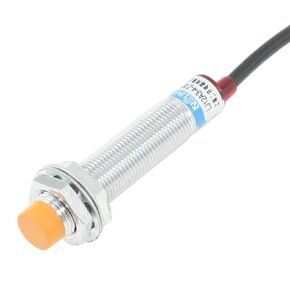- Shopping, made easy.
- /
- Get the app!
After supplying power to the switch, the oscillator in the high-frequency oscillation circuit generates an alternating electromagnetic field on the detection surface of the switch. When a metal approaches the detection surface of the switch, the eddy currents inside the metal absorb the energy of the alternating electromagnetic field in the oscillator, causing it to weaken or stop oscillating. The two states of energy change in the oscillator are converted into a level signal by the detection circuit. The level signal is amplified by the amplification circuit and triggered by the trigger circuit to output the transistor circuit, generating a switching signal. So as to detect the presence of metals and achieve the purpose of detecting metals.
a. Basic parameters
1. Product model: LJ12A3-4-Z/BX
2. Working voltage: 6-36VDC
3. Detection distance: 0-4mm
4. Load current: 5. Output form: NPN three wire (non embedded)
6. Output status: Normally open (NO)
7. Output level: Low level (when metal is present)
8. Testing substances; Metal objects
9. Product material: Copper/PBT
10. External lead: 1.2 meters
11. Output indicator: LED (red)
12. Product dimensions: 12mm diameter, 40mm thread length, 60mm total length
b. Characteristic parameters
1. Hysteresis distance: 2. Current consumption: 3. Protection functions: power reverse protection, surge protection, load short circuit protection
4. Operating environment: -30 ° C to+70 ° C/-30% to+95% RH
5. Insulation impedance:>50M Ω
6. Temperature influence: Temperature range -30 ° C to+65 ° C, within ± 15% detection distance. 7. Voltage influence: Within ± 15% of rated power supply voltage range, switch detection distance influence ± 10%; When the power supply voltage exceeds the rated voltage by 15%, it will cause damage to the power supply when turned on
8. Design structure: IP67 (IEC specification)
 ATO M12 Photoelectric Switch Sensor, DC 6-36V Proximity Sensor, NPN NC
KWD 8
ATO M12 Photoelectric Switch Sensor, DC 6-36V Proximity Sensor, NPN NC
KWD 8
 Heschen M18 Inductive Proximity Sensor Switch Shield Type LJ18A3-5-Z/BY Detector 5mm 10-30VDC 200mA PNP Normally Open(NO) 3 Wire
KWD 3.500
Heschen M18 Inductive Proximity Sensor Switch Shield Type LJ18A3-5-Z/BY Detector 5mm 10-30VDC 200mA PNP Normally Open(NO) 3 Wire
KWD 3.500
 SparkFun Current Sensor Breakout - ACS723 - Moderate AC and DC Current Sensing Applications - Base Sensitivity of 400mV/A - Full Electrical Isolation of Measured and sensed Circuits
KWD 6
SparkFun Current Sensor Breakout - ACS723 - Moderate AC and DC Current Sensing Applications - Base Sensitivity of 400mV/A - Full Electrical Isolation of Measured and sensed Circuits
KWD 6
 -13%
uxcell 6-36VDC 4mm Detecting Distance PNP NO Inductive Proximity Switch LJ12A3-4-Z/BY
KWD 3.500
-13%
uxcell 6-36VDC 4mm Detecting Distance PNP NO Inductive Proximity Switch LJ12A3-4-Z/BY
KWD 3.500